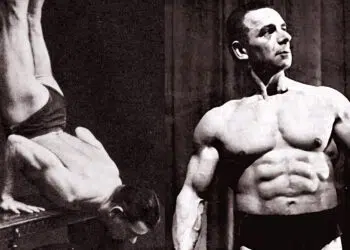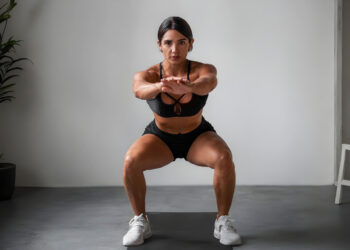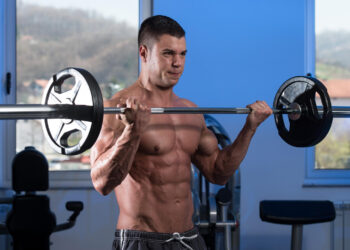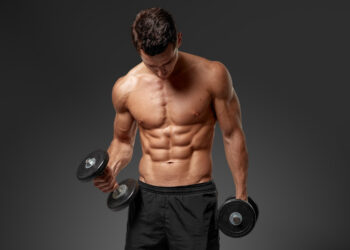Developing and then maintaining muscle mass takes a lot of time and effort. It doesn’t matter if you are a wannabe bodybuilder or just want to look good naked, you’ll need to commit to training regularly and consistently.
Sadly, missing more than a couple of workouts can quickly lead to muscle atrophy, and you’ll soon begin to lose your hard-won gains.
In an ideal world, you’ll never miss a workout, let alone several in a row, but life has a way of undoing the best-laid plans. Gyms close for holidays or repairs, family and work commitments take precedence over training, and, sometimes, you just run out of time.
The good news is that you can get a great workout at home using nothing other than a set of resistance bands. You can replicate most freeweight and machine exercises with bands, and you can even use them to make many bodyweight exercises more effective.
So, buy a set of resistance bands and keep them at home so you always have a way to train even when you can’t make it to the gym. You can also take your bands on vacation, so you never need to miss another workout.
Not sure where to start with resistance band training? Try our full-body resistance band workout for home exercisers!
Level Up Your Fitness: Join our 💪 strong community in Fitness Volt Newsletter. Get daily inspiration, expert-backed workouts, nutrition tips, the latest in strength sports, and the support you need to reach your goals. Subscribe for free!
Resistance Band Workout for Home Exercisers
Do this workout anytime you need a training fix but can’t make it to the gym. Alternatively, you can do this workout 2-3 times a week and never step foot in a gym again!
But, before you start, make sure you spend a few minutes warming up and preparing your muscles and joints for the workout you’re about to do. Begin with 5-10 minutes of easy cardio, e.g., jogging or jump rope, and then do some dynamic mobility and flexibility exercises for your major muscles and joints.
| # | Exercise | Sets | Reps | Recovery |
| 1 | Resistance band goblet squat | 4 | 10-15 | 60 seconds |
| 2 | Resistance band good morning | 4 | 10-15 | 60 seconds |
| 3 | Resistance band push-up | 3 | 10-15 | 60 seconds |
| 4 | Resistance band seated row | 3 | 10-15 | 60 seconds |
| 5 | Resistance band sumo deadlift high-pull | 3 | 15-20 | 60 seconds |
| 6 | Resistance band shoulder press | 2 | 10-15 | 60 seconds |
| 7 | Resistance band lat pulldown | 2 | 10-15 | 60 seconds |
| 8 | Resistance band triceps pushdown | 2 | 10-15 | 60 seconds |
| 9 | Resistance band biceps curl | 2 | 10-15 | 60 seconds |
| 10 | Resistance band kneeling crunch | 2 | 15-20 | 60 seconds |
| 11 | Resistance band Pallof press | 2 | 10-15 | 60 seconds |
Please Note: Repetition ranges are for illustration purposes only. Depending on the strength of your bands, you may need to do fewer or more reps. So, to get the most from this workout, just keep going until you are within a couple of reps of failure.
Exercise Descriptions
One of the benefits of resistance bands is that they’re very safe. The tension on your muscles increases gradually, which means less stress for your tendons and ligaments and less wear and tear on the articular surfaces of your joints.
However, while injuries are rare with resistance bands, it’s still possible to do the exercises in this workout incorrectly. Not only could poor form lead to aches and pains, but it could also make your workout less effective.
So, enjoy all the benefits of this workout while keeping your risk of injury to a minimum by doing each exercise correctly. Follow the instructions below for the best results.
Check your bands for cuts, nicks, and damage before using. A band that snaps unexpectedly can cause serious injury!
1. Resistance bend goblet squat
Goblet squats are traditionally done using a kettlebell or single dumbbell. They work all your major leg muscles, including the quadriceps, hamstrings, and glutes. This exercise works equally well with a resistance band and, because of the increased tension at the end of each rep, really hits your quads hard.
How to do it:
- Stand on the center of your band with your feet about shoulder-width apart and toes turned slightly outward.
- Hold the band with your hands together and clasped under your chin. Brace your abs and look straight ahead.
- Bend your knees, push your hips back, and squat down until your thighs are roughly parallel to the floor. Do not round your lower back. Squat deeper if your flexibility and knee health allow.
- Stand back up and repeat.
2. Resistance band good morning
Good mornings are so-called because, when you do them, it looks like you are bowing politely to greet someone. Usually done with a barbell, this exercise works equally well and is arguably safer when you do it with a resistance band. Good mornings work your glutes, hamstrings, and lower back.
How to do it:
- Stand on your resistance band with your feet parallel and about hip-width apart. Squat down and loop the center of the band over the back of your neck and then stand up. Hold the band at shoulder height, taking a little pressure off your neck.
- Bend your knees slightly for stability and brace your abs.
- Without bending your knees further or rounding your lower back, push your butt backward and hinge at the hips. Lean as far over as your flexibility allows.
- Drive your hips forward and stand back up.
3. Resistance band push-up
The humble push-up is a great chest, triceps, and shoulder exercise, but it’s also quite an easy one. Crank up the intensity of your workout by doing push-ups with a resistance band. But, of course, if you find bodyweight-only push-ups challenging enough, feel free to do them without the band.
How to do it:
- Loop your resistance band around your upper back. The band can run outside or inside your arms as preferred. The tighter the band, the more intense the exercise will be.
- Squat down and place your hands on the floor so they’re slightly wider than shoulder-width apart. Walk your feet back, so your body is straight. Brace your core.
- Bend your arms and lower your chest down to within an inch of the floor.
- Push yourself back up so your arms are straight but not locked, and repeat.
4. Resistance band seated row
No cable machine? Don’t worry – you can still work your upper back and do seated rows. This exercise works your latissimus dorsi, middle traps, rhomboids, posterior deltoids, and biceps, which means it provides a good balance to the push-ups you’ve just done. This is an excellent postural exercise.
How to do it:
Level Up Your Fitness: Join our 💪 strong community in Fitness Volt Newsletter. Get daily inspiration, expert-backed workouts, nutrition tips, the latest in strength sports, and the support you need to reach your goals. Subscribe for free!
- Sit on the floor with your legs extended. Your torso should be upright, so no slouching! Sit on a raised surface, e.g., a yoga block, if you can’t straighten your legs.
- Loop your resistance band over your feet and hold the ends in your hands.
- Keeping your upper arms close to your sides, bend your elbows and pull back and into your lower ribs.
- Extend your arms and repeat.
5. Resistance band sumo deadlift high-pull
Barbell sumo deadlift high-pulls are something of a CrossFit staple. Working your legs, core, and upper body, they’re great for circuit training and HIIT workouts. SDHPs are also a useful full-body strengthening exercise. This exercise works particularly well with a resistance band.
How to do it:
- Stand on your band, so your feet are about one-and-a-half shoulder widths apart. Turn your toes out slightly. Hold the center of your band with your hands close together.
- Bend your legs and reach your hands down between your knees. Do not round your lower back.
- Drive your feet into the floor and stand up, simultaneously pulling upward with your arms until your hands are just below your chin.
- Lower your hands and repeat.
6. Resistance band shoulder press
As you’d expect from an exercise with the word shoulder in its name, the shoulder press works your deltoids as well as your triceps. Depending on the length and strength of your band, you can do this exercise standing, kneeling, or seated.
How to do it:
- Stand on the center of your band and hold the ends in your hands. Bring your hands up to shoulder height, palms facing forward. Bend your knees slightly for stability and brace your abs.
- Push your hands up and overhead until your elbows are straight but not locked.
- Lower your hands back to your shoulders and repeat.
- If your band is short or tight, you can kneel on it or loop it under a chair to make this exercise more manageable.
7. Resistance band lat pulldown
Lateral or lat pulldowns work your latissimus dorsi and biceps. It’s a popular exercise, and most gyms have a lat pulldown machine. You can also do this exercise at home with nothing more than a resistance band and a high anchor point. If you’ve got a power tower at home, you can do pull-ups instead of lat pulldowns.
How to do it:
- Attach your band to an overhead anchor. For example, loop it over a ceiling joist, or shut it in the top of a door. Hold the other ends in your hands while facing the anchor point. After making sure your band is secure, kneel down and extend your arms overhead. Lean back slightly.
- Bend your elbows and pull your hands down to your shoulders. Keep your chest up and your shoulders down and back.
- Extend your arms and repeat.
8. Resistance band triceps pushdown
Up until now, all the exercises in this full-body workout have been compound in nature. That means they involve multiple joints and muscles working together. Your next exercise is an isolation exercise, meaning only one joint is moving.
As their name implies, the triceps pushdown works your triceps muscle, which is located on the back of your upper arm.
How to do it:
- Attach your resistance band to an overhead anchor. Alternatively, shut it in the top of a door.
- Hold the band and pull your elbows down and into your sides. Brace your abs and pull your shoulders down and back.
- Keeping your upper arms stationary, extend your elbows, and push your hands down to your thighs.
- Bend your arms again and repeat.
9. Resistance band biceps curl
Even if you aren’t a budding bodybuilder, you probably still want toned, defined biceps. After all, the biceps are probably the most famous muscle in the human body. Resistance band curls, combined with triceps pushdowns, will help you sculpt the arms of your dreams.
How to do it:
- Stand on the middle of your band with your feet about hip-width apart. Bend your knees slightly for stability. Hold the ends of the bands with your hands supinated or palms-up. Brace your abs.
- Bend your arms and curl your hands up to your shoulders.
- Extend your arms and repeat.
- You can also do this exercise with a neutral or palms-in grip, i.e., hammer curls.
10. Resistance band kneeling crunch
While there is nothing wrong with training your core on the floor, mat exercises can get pretty boring if you do them too often. This move replicated cable machine crunches, which is a popular and effective exercise for the muscle at the front of your abdomen – the rectus abdominus.
How to do it:
- Attach your resistance band to an overhead anchor. Alternatively, shut it in the top of a door.
- Hold the band and then kneel down facing your anchor point. Pull your hands down to your shoulders and keep them there.
- Flex your spine and draw your shoulders down toward your hips.
- Return to the starting position and repeat.
11. Resistance band Pallof press
Pallof presses are named after their inventor, physical therapist John Pallof. They work your entire core, especially your obliques. This is an anti-rotation exercise, meaning your muscles must work isometrically to prevent unwanted movement.
How to do it:
- Attach your resistance band to a chest-high anchor. Alternatively, shut it in a door.
- Stand side onto the anchor and hold the end of the band in front of your chest. Stand with your feet about shoulder-width apart with your knees slightly bent for balance. Brace your core.
- Extend your arms in front of you, feeling the tension increase within your core. Do not turn your torso.
- Bring your hands back to your chest and repeat.
- On completion, turn and face the other way to work the opposite side of your core.
Full-Body Resistance Band Workout
A lot of exercisers are very quick to dismiss resistance bands, thinking they’re inferior to freeweights or less effective than machines. This point of view couldn’t be further from the truth!
Resistance band exercises are every bit as effective as their freeweight, bodyweight, and machine equivalents and are often safer too. Plus, you can take your bands with you wherever you go – it’s like having an entire gym in a bag.
So, the next time you cannot make it to the gym, or just fancy a change from lifting weights, break out your resistance bands and pump some rubber instead. This home workout is an excellent introduction to the benefits of resistance band training.









I want to express my gratitude for this article on correct exercise sequencing for better workouts. As someone who is always searching for effective workout routines, this information is valuable and timely.
The article starts by acknowledging the abundance of workout resources available online, but it also highlights the challenge of finding reliable and well-structured routines. This is a common concern for many people, including myself, as we want to make the most of our time and effort during workouts.
The emphasis on exercise sequencing is intriguing. I appreciate that the article recognizes the importance of proper order and arrangement of exercises to optimize results. It would be helpful if the article delved deeper into the specific benefits of correct exercise sequencing. How does it impact muscle activation, energy expenditure, or overall workout efficiency? Providing more insight into the science behind exercise sequencing would be valuable.
I also appreciate the mention of warm-up and cool-down exercises. These are often overlooked but crucial components of a workout. It would be beneficial if the article provided examples or suggestions for effective warm-up and cool-down routines to complement the sequencing of exercises. Practical tips and guidelines would be greatly appreciated.
Furthermore, it would be interesting to explore the concept of exercise pairing or supersets within the context of sequencing. How can combining specific exercises enhance the effectiveness of a workout? Exploring different techniques or strategies for exercise pairing would add depth to the article’s content.
Overall, I am thankful for this article’s focus on correct exercise sequencing. It has reminded me of the importance of structuring workouts properly to maximize benefits. I would love to see further exploration of the science behind sequencing, practical tips for warm-up and cool-down routines, and the potential benefits of exercise pairing. Thank you for sharing this informative piece, and I look forward to implementing these principles into my future workouts.